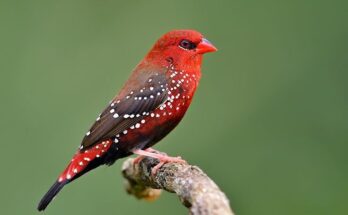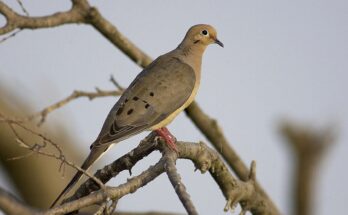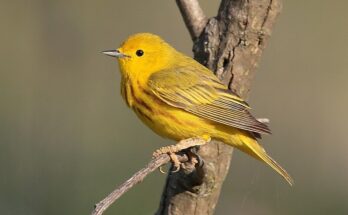Hawaii’s allure isn’t just its beaches; the Finches in Hawaii are a marvel, with 280 species making the islands their sanctuary. Many were introduced and thrive in urban areas, but it’s the native species that captivate. In my research, I’ve discovered these indigenous birds offer a unique glimpse into Hawaii’s ecosystem. They’re a must-see for any nature enthusiast visiting the islands.
One group of native birds is the Hawaiian finches, also called honeycreepers. Also, These little birds are part of the Fringillidae family. They mostly eat nectar or insects and live in the remote forests of Hawaii. Because they live in such isolated places and there aren’t many of them, we still have a lot to learn about their lives. Unfortunately, many of these colorful birds are in danger because of other animals that were brought to Hawaii.
Moreover, There are lots of great places in Hawaii to see birds and keep them safe. Also, Some of these spots include Wailoa River State Park, James Campbell National Wildlife Refuge, Kealia Pond National Wildlife Refuge, Pearl Harbour National Wildlife Refuge, and Kanaha Pond Wildlife Sanctuary. But there are also other places where you can find Hawaiian finches that aren’t as well known.
We’ll Learn About 9 Finches That You Can See In Hawaii
1. Akekee
- Scientific name – Loxops caeruleirostris
- Lifespan – Unknown
- Size (average) – 3.9 in (10 cm)
- Status – Critically endangered
The male Akekee sports vibrant green on its upper parts, complemented by yellow underparts and a sunny yellow head topped with a small black mask. Females share a similar appearance but with a more muted palette. Both sexes boast a distinctive crossed, pale beak. When it comes to communication, they produce a sweet “suweet” call and serenade with a fluctuating trill.
These precious birds call the lofty heights of Ohia trees home, where they presumably raise multiple broods from March to July, each clutch typically containing one to three eggs. Their nests, small cup-shaped constructions of sticks, perch delicately on the branches of Ohia trees.
Diet-wise, the Akekee finches in hawaii is quite the opportunist, dining on larvae, spiders, and various insects.
Sadly, the Akekee’s numbers are plummeting at an alarming rate. With an estimated population of only about 1100 birds, it has declined by a staggering 98% since 2000. Its plight is worsened by invasive plants encroaching on its habitat, habitat degradation, diseases, competition with invasive insects, and predation.
It’s crucial that we rally together to protect and preserve these remarkable creatures before it’s too late.
2. Akiapolaau
- Scientific name – Hemignathus wilsoni
- Lifespan – 13 years (maximum recorded)
- Size (average) – 5.5 in (14 cm)
- Weight (average) – 1 oz (28.3 g)
- Wingspan – 7 to 7.8 in (18 to 20 cm)
- Status – Endangered
The male Akiapolaau bird has a back that’s greenish-yellow, with a yellow belly, and its head wears a black mask. The female, on the other hand, has an olive-colored back and a grayish-yellow belly. Both males and females have a unique beak, with a longer, curved upper part and a short, chisel-like lower part. When they chirp, they make a sound like “chuw-ee” or “teedle-oo.”
These birds, called Akiapolaau, mate all year round, but they mostly do so between February and July. They build their nests from sticks and place them in Ohia trees. Normally, they lay one or two eggs at a time.
Akiapolaau finches in hawaii mainly eat insects, larvae, and spiders, but they also enjoy sap.
Sadly, the Akiapolaau is in danger. There are only about 1900 of them left, and their numbers are dropping. They face threats like losing their homes because of construction, getting sick, invasive species, and other animals eating them
3. Akikiki
- Scientific name – Oreomystis bairdi
- Lifespan – Unknown
- Size (average) – 5.1 in (13 cm)
- Weight – 0.4 to 0.6 oz (12 to 17 g)
- Wingspan – Unknown
- Status – Critically endangered
Both male and female Akikiki birds have white bellies, grayish backs, and pink beaks. They sing a trilling song and make a quiet squeaking sound.
These birds, known as Akikiki, usually breed from March to June, and they build their nests in Ohia trees. Their nests are made from bark, moss, lichen, and plant fibers. Typically, they lay one or two eggs at a time.
The Akikiki mostly eats tiny creatures like insects and spiders.
Unfortunately, the Akikiki is in critical danger. There are fewer than 76 of them left, and their numbers are dropping fast. Their habitat is shrinking by 90%, and they face threats like diseases, losing their homes because of construction, natural disasters, competition with other birds and bugs, and other animals eating them
4. Akohekohe
- Scientific name – Palmeria dolei
- Lifespan – 9 years (maximum recorded)
- Size – 6.7 to 7 in (17 to 18 cm)
- Weight – Unknown
- Wingspan – Unknown
- Status – Critically endangered
Male and female Akohekohe birds wear black feathers adorned with white, grey, yellow, silver, or orange tips. They sport a striking orange eye-ring and an orange patch on the back of their neck. Their thighs range from orange to yellow-white, and they boast a large white crest on their heads. When they sing, they produce a mix of whistles, gurgles, and buzzes.
These birds, called Akohekohe, build cup-shaped nests, typically nestled in Ohia trees. They usually lay one or two eggs at a time.
Akohekohe birds mainly dine on nectar but also snack on some small arthropods.
Sadly, the Akohekohe is in critical danger. There are only about 2500 of them left, and their numbers are going down. They face threats like losing their homes because of construction, being eaten by other animals brought to Hawaii, and getting sick.
If you’re looking to spot an Akohekohe, head to Haleakala National Park on Maui. These rare birds live in forests filled with Ohia, Koa, Kawau, and Olapa trees, at altitudes ranging from 5,000 to 7,000 feet (1525 to 2133 meters)
Read More: 7 Types Of Finches in Michigan
5. Anianiau
- Scientific name – Magumma parva
- Lifespan – 9 years (maximum recorded)
- Size (average) – 3.9 in (10 cm)
- Weight – 0.32 to 0.35 oz (9 to 10 g)
- Wingspan – Unknown
- Status – Vulnerable
Meet the Anianiau bird – the males sport a sunny yellow hue, while the females lean towards a softer yellowish-green. Their song is a cheerful trill that goes like “weesee-weesee-wee-see”, while their call is a sweet “su-weet”.
Come breeding season, which spans from February to June, these birds construct cozy cup-shaped nests. Each clutch typically contains up to three eggs.
When it’s mealtime, the Anianiau dines on a menu of insects, spiders, nectar, and fruit.
While they’re classified as vulnerable, there’s some good news: their population trend is holding steady. Currently, there are around 8,700 of these birds in existence, but their habitat has shrunk by a substantial 85% from its historical range. Threats like diseases, habitat loss, competition from introduced species, and predation loom over their future.
6. Apapane
- Scientific name – Himatione sanguinea
- Lifespan – 11 years (maximum recorded)
- Size (average) – 5.1 in (13 cm)
- Weight – 0.5 to 0.56 oz (14.4 to 16 g)
- Wingspan – Unknown
- Status – Least concern
Both male and female Apapane birds are a vibrant crimson color all over, with black wings, a black upper tail, black legs, and a white patch on their rump. Their song sounds like “dee-der-di-di-di.”
These birds, known as Apapane, build their nests in Ohia trees, crafting cup-shaped homes from moss, twigs, lichen, bark, leaves, and roots. They typically lay up to three eggs at a time and usually breed between January and March.
These finches of hawaii mostly sip nectar for their meals.
Thankfully, the Apapane is not currently in danger, with a stable population of around 1,300,000 individuals. However, they still face threats like losing their homes because of construction, being eaten by other animals, getting sick, and competing with other birds for food and space
7. Hawaii Akepa
- Scientific name – Loxops coccineus
- Lifespan – 10 years (maximum recorded)
- Size – 3.9 to 5.1 in (10 to 13 cm)
- Weight – 0.3 to 0.4 oz (10 to 12 g)
- Wingspan – 2.3 to 2.7 in (6 to 7 cm)
- Status – Endangered
Let’s talk about the Hawaii Akepa bird. The guys rock a vibrant orange look, while the gals go for a more subdued greenish-grey, jazzed up with a yellow band across their chests. Both sport a pale beak with a cute cross.
When it comes to music, they’re quite the singers, belting out a trilly tune and a soft “tiddle-ee” call.
For nesting, they cozy up in tree hollows of Ohia and Koa trees, with breeding season running from March to June. Each clutch usually holds one or two eggs.
Their diet? Mostly insects.
Sadly, these birds are in trouble. Once found on Oahu and Maui, they’re now limited to Hawaii Island. With only about 14,000 individuals left, their numbers are dropping. Threats like habitat loss, diseases, and predators are putting the squeeze on their survival.
8. Hawaii Amakihi
- Scientific name – Chlorodrepanis virens
- Lifespan – 12 years (maximum recorded)
- Size (average) – 4.3 in (11 cm)
- Weight – 0.3 to 0.6 oz (10 to 16 g)
- Wingspan – Unknown
- Status – Least concern
The male Hawaii Amakihi bird sports a yellow-green or olive-colored body, with a black curved beak, a light-colored face, black spots near its eyes, and lighter-colored belly feathers. The female looks similar to the male but with less bright feathers. Also, This bird sings a trilling song and makes a “chee” sound.
Besides this, These birds also, called Hawaii Amakihi, create cup-shaped nests using twigs, grass, and leaves. The female usually lays two to three eggs at a time, and they mate all year round.
Hawaii Amakihi birds munch on insects, nectar, and fruit for their meals.
The Hawaii Amakihi isn’t considered to be in danger right now because it’s adaptable and can handle changes in its environment better than some other native Hawaiian finches which is really impressive. However, it’s no longer found on Lanai. We’re not sure exactly how many there are, but their population seems steady. Still, they could face problems like losing their homes because of construction, getting sick, or other animals eating them
9. Hawaii Creeper
- Scientific name – Loxops mana
- Lifespan – Unknown
- Size – 4.3 to 5.1 in (11 to 13 cm)
- Weight – 0.4 to 0.5 oz (13 to 15 g)
- Wingspan – Unknown
- Status – Endangered
Both male and female Hawaii Creeper birds have olive-green backs, light-colored bellies, and a dark grey mask on their faces. Males tend to be a bit more colorful than females. These birds sing a trilling song and make a squeaking “squeet” sound.
The Hawaii Creeper builds its nest in open cup shapes, usually in holes or gaps in tree bark. Females typically lay two eggs at a time.
For meals, Hawaii Creeper birds prefer insects, spiders, and other small creatures without backbones.
Unfortunately, the Hawaii Creeper is endangered. There are only about 12,000 of them left, and their numbers are dropping. They used to live at lower altitudes but now only stay in higher places. They face dangers like being eaten by other animals, getting sick, competing with other birds, losing their homes because of construction, and having their habitats broken up



